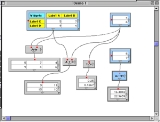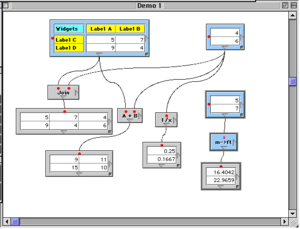
Spreadsheet 2000
Encyclopedia
Spreadsheet 2000 was a spreadsheet
program for Apple Macintosh computers, published by Casady & Greene
, a distributor of many "smaller" Mac releases. It appears to have seen little in terms of sales, and was withdrawn from the market after only a short time (ironically before the year 2000). Originally known as Let's Keep It Simple Spreadsheet, officially abbreviated Let's KISS, the product was renamed Spreadsheet 2000 for its 2.0 release.
Spreadsheet 2000, S2K for short, featured a unique way of building complex spreadsheets from a number of simpler ones containing only input or output data. This contrasts with the traditional spreadsheet model, where inputs, calculations and outputs are all placed into a single sheet and cannot be easily differentiated. For instance, if one wants to add two columns of three numbers, under a normal spreadsheet one would type the two sets of values into columns, say A and B, and then into C type the formula =A1+B1, which would appear on-screen as the results. The formula is then copied into the other cells in C. A user looking at the sheet would simply see three columns of numbers, and has no way to differentiate which values are the inputs and which the outputs.
 Under S2K the same task is separated out to make it easier to understand. The user would first create two separate "sheetlettes" containing one column each, type the input numbers into them, and then connect the two together with the addition function, represented by an icon. The addition icon also has an output connector, and when this is connected to a third sheetlette, the results of the addition appear there automatically. The user could also connect the output to a sheetlette containing a single cell, in which case the addition function would sum the all of the cells and display the single result.
Under S2K the same task is separated out to make it easier to understand. The user would first create two separate "sheetlettes" containing one column each, type the input numbers into them, and then connect the two together with the addition function, represented by an icon. The addition icon also has an output connector, and when this is connected to a third sheetlette, the results of the addition appear there automatically. The user could also connect the output to a sheetlette containing a single cell, in which case the addition function would sum the all of the cells and display the single result.
Since every step of a calculation was represented by input and output sheetlettes as well as the operator icons, S2K worksheets could become cluttered. In order to address this, whole groups of sheets and icons could be selected and collapsed into a compound operator. From that point on the operator worked just like one of S2K's built-in functions, allowing the user to connect inputs and outputs to it as normal.
The whole idea of S2K was to simplify the construction of simple spreadsheets. While it met that goal, the same features made more complex spreadsheets difficult to work with. For instance, trying to debug a complex formula in Excel simply requires the user to click on the cell and read the formula. The same task in S2K may be difficult, the formula filling several pages, or alternately being built several layers deep (compounds of compounds) so that there is no single view of the formula. Additionally S2K's own set of built-in functions was rather limited.
S2K was written entirely in Prograph
.
Spreadsheet
A spreadsheet is a computer application that simulates a paper accounting worksheet. It displays multiple cells usually in a two-dimensional matrix or grid consisting of rows and columns. Each cell contains alphanumeric text, numeric values or formulas...
program for Apple Macintosh computers, published by Casady & Greene
Casady & Greene
Casady & Greene, founded in 1984 by Robin Casady, was a software publisher of shareware products, primarily for the Macintosh. C&G published fonts in the earlier days of desktop publishing; founder Casady partnered with Michael Greene, founder of Greene Inc who developed QuickDex. An expansion into...
, a distributor of many "smaller" Mac releases. It appears to have seen little in terms of sales, and was withdrawn from the market after only a short time (ironically before the year 2000). Originally known as Let's Keep It Simple Spreadsheet, officially abbreviated Let's KISS, the product was renamed Spreadsheet 2000 for its 2.0 release.
Spreadsheet 2000, S2K for short, featured a unique way of building complex spreadsheets from a number of simpler ones containing only input or output data. This contrasts with the traditional spreadsheet model, where inputs, calculations and outputs are all placed into a single sheet and cannot be easily differentiated. For instance, if one wants to add two columns of three numbers, under a normal spreadsheet one would type the two sets of values into columns, say A and B, and then into C type the formula =A1+B1, which would appear on-screen as the results. The formula is then copied into the other cells in C. A user looking at the sheet would simply see three columns of numbers, and has no way to differentiate which values are the inputs and which the outputs.

Since every step of a calculation was represented by input and output sheetlettes as well as the operator icons, S2K worksheets could become cluttered. In order to address this, whole groups of sheets and icons could be selected and collapsed into a compound operator. From that point on the operator worked just like one of S2K's built-in functions, allowing the user to connect inputs and outputs to it as normal.
The whole idea of S2K was to simplify the construction of simple spreadsheets. While it met that goal, the same features made more complex spreadsheets difficult to work with. For instance, trying to debug a complex formula in Excel simply requires the user to click on the cell and read the formula. The same task in S2K may be difficult, the formula filling several pages, or alternately being built several layers deep (compounds of compounds) so that there is no single view of the formula. Additionally S2K's own set of built-in functions was rather limited.
S2K was written entirely in Prograph
Prograph
Prograph is a visual, object-oriented, dataflow, multiparadigm programming language that uses iconic symbols to represent actions to be taken on data. Commercial Prograph software development environments such as Prograph Classic and Prograph CPX were available for the Apple Macintosh and Windows...
.

